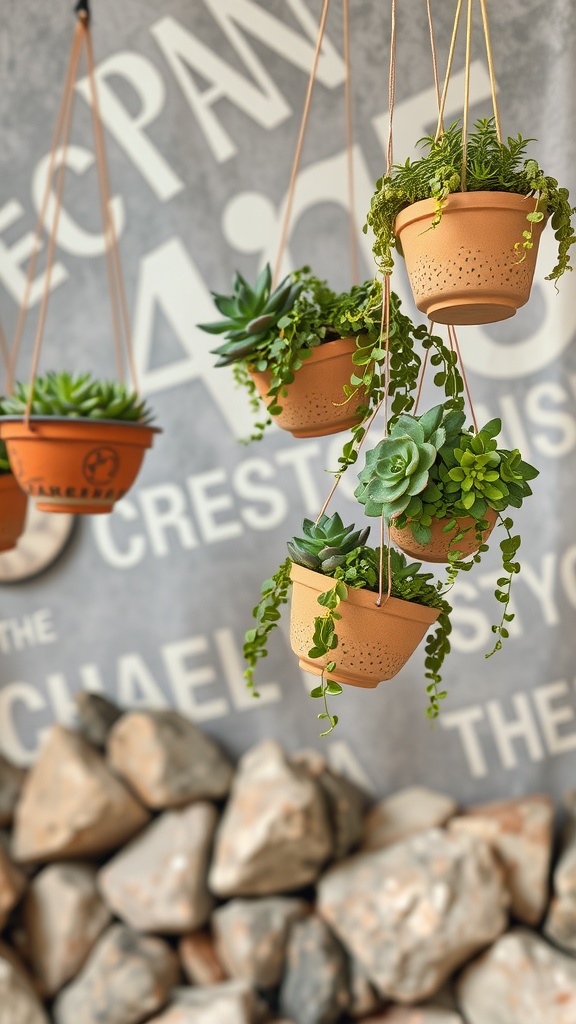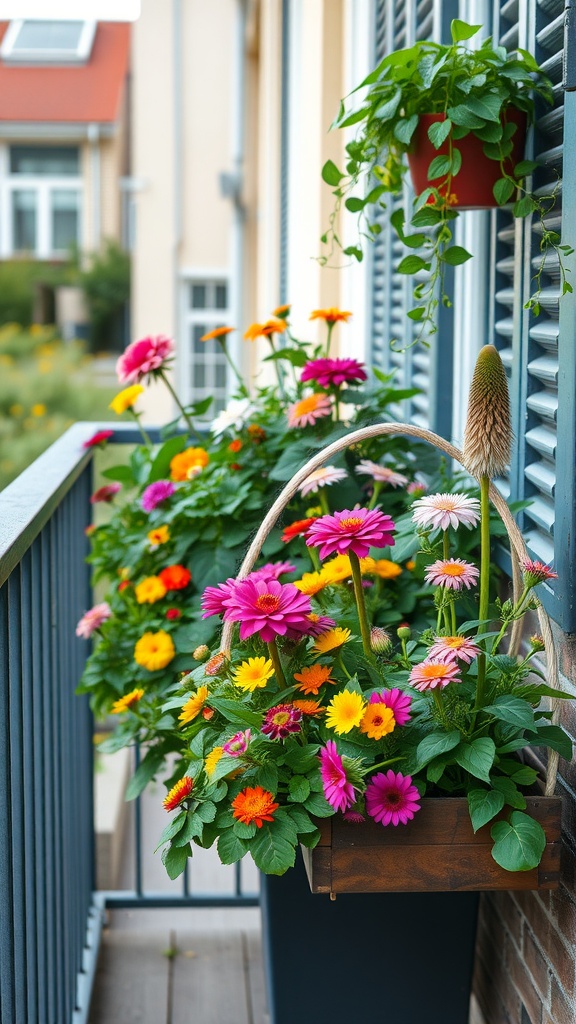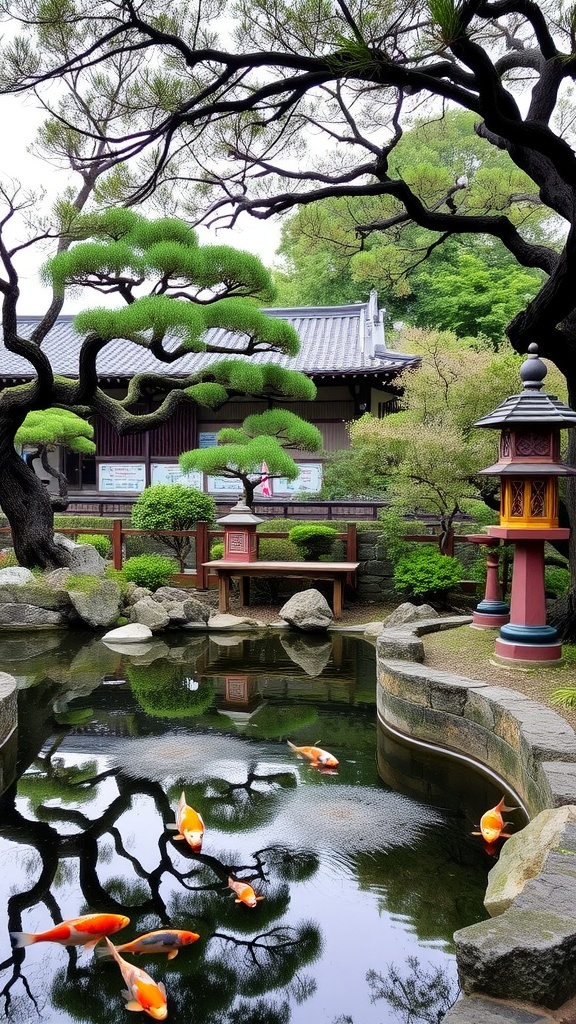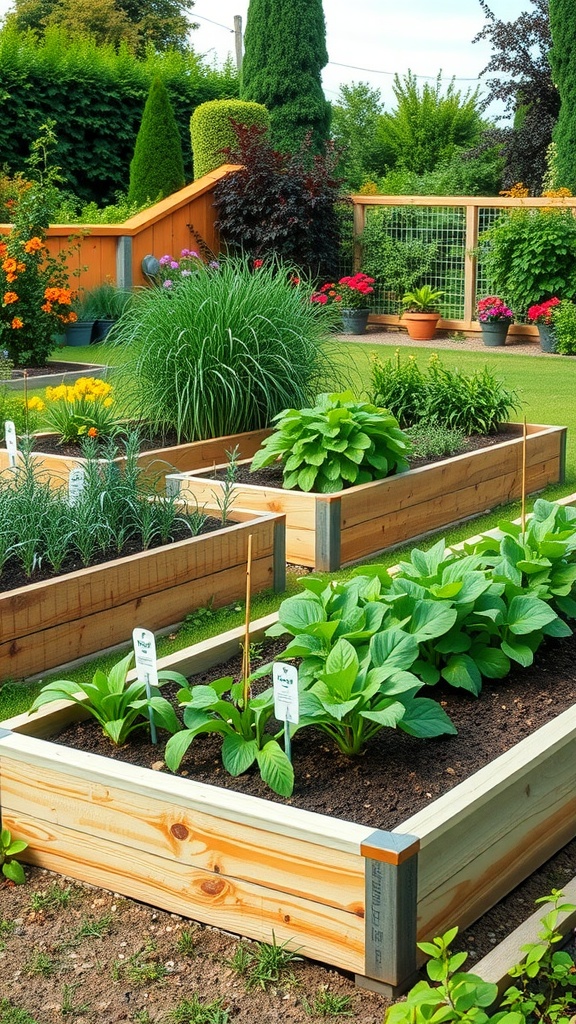If you’re looking to create a dry garden that’s both stylish and low-maintenance, you’ve come to the right place! We’ve gathered 27 creative ideas to help you design an outdoor space that thrives on minimal water while still looking appealing. Whether you prefer a modern aesthetic or a more rustic feel, there’s something here to inspire your next gardening project.
Drought-Resistant Perennials

Drought-resistant perennials are a fantastic choice for anyone looking to create a low-maintenance garden. The image above showcases a vibrant patch of daisies blooming against a dry, rocky backdrop. These flowers thrive in conditions where water might be scarce, making them ideal for dry gardens.
With their cheerful colors, these perennials not only add beauty but also resilience. They require minimal watering once established, which is a huge plus in areas prone to drought. Pairing them with other drought-tolerant plants can create a diverse and visually appealing landscape.
When planning your drought-resistant garden, consider the placement of perennials like these daisies. They can serve as focal points or ground cover. Their unique ability to withstand tough conditions while still being visually pleasing makes them a great choice for sustainable gardening.
Mediterranean Herbs
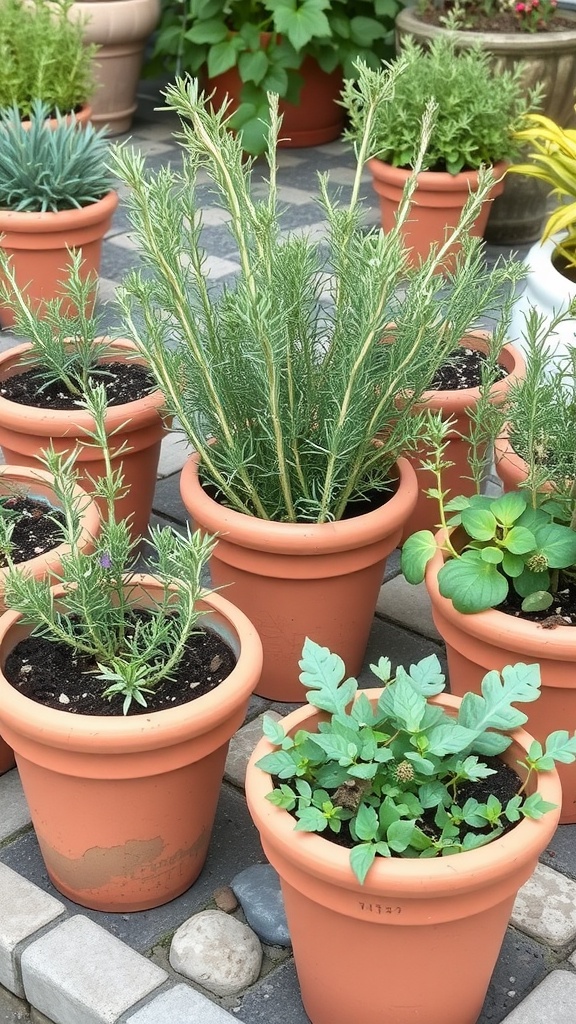
When you think of Mediterranean gardens, the first thing that comes to mind is a delightful array of herbs. The image captures several pots filled with vibrant Mediterranean herbs like rosemary, thyme, and lavender. These herbs are not just beautiful; they also add amazing flavors to your dishes.
Growing these herbs in pots is a fantastic way to create a dry garden in limited spaces. The terracotta pots help regulate moisture, preventing roots from sitting in water. This makes them ideal for dry climates and adds charm to your outdoor area.
To start your herb garden, choose pots with good drainage. Fill them with well-draining soil and plant your favorite Mediterranean herbs. Water them lightly and place them in a sunny spot. Regular pruning helps maintain their growth and encourages new leaves. Not only do they look nice, but they can also be used in various recipes!
Ornamental Grasses
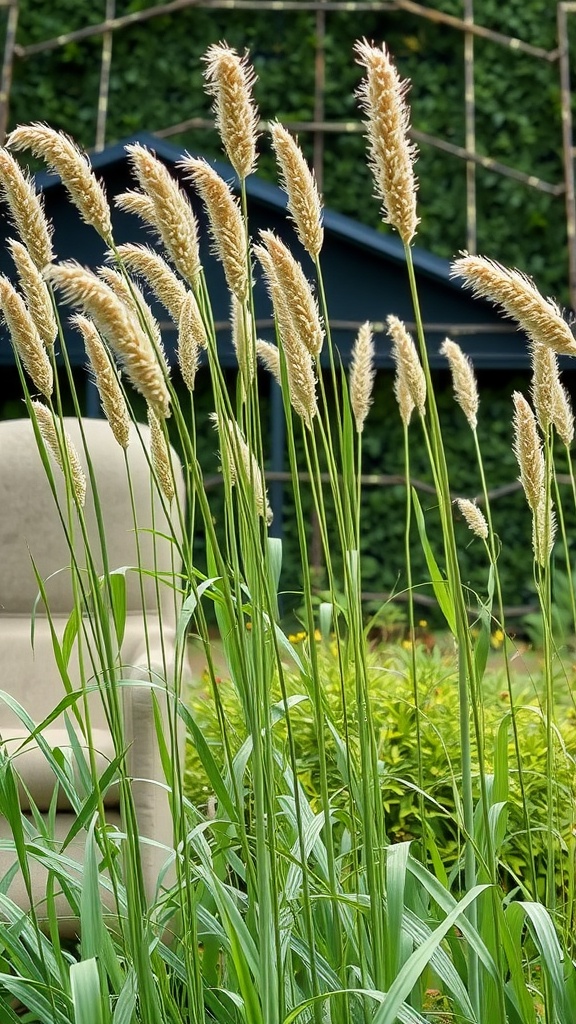
Ornamental grasses add texture and movement to any dry garden. In the image, we see tall grasses with fluffy, golden plumes swaying gently in the breeze. This creates a lovely visual contrast with their vibrant green leaves.
These grasses are not just pretty; they serve practical purposes too. They can help stabilize soil and provide habitat for wildlife. Plus, their low maintenance needs make them a smart choice for any garden.
Incorporating ornamental grasses can truly enhance your garden’s aesthetic. Their height and form can create layers and depth, making even a small space feel expansive. You can pair them with other drought-resistant plants for a cohesive look.
Gravel Pathways
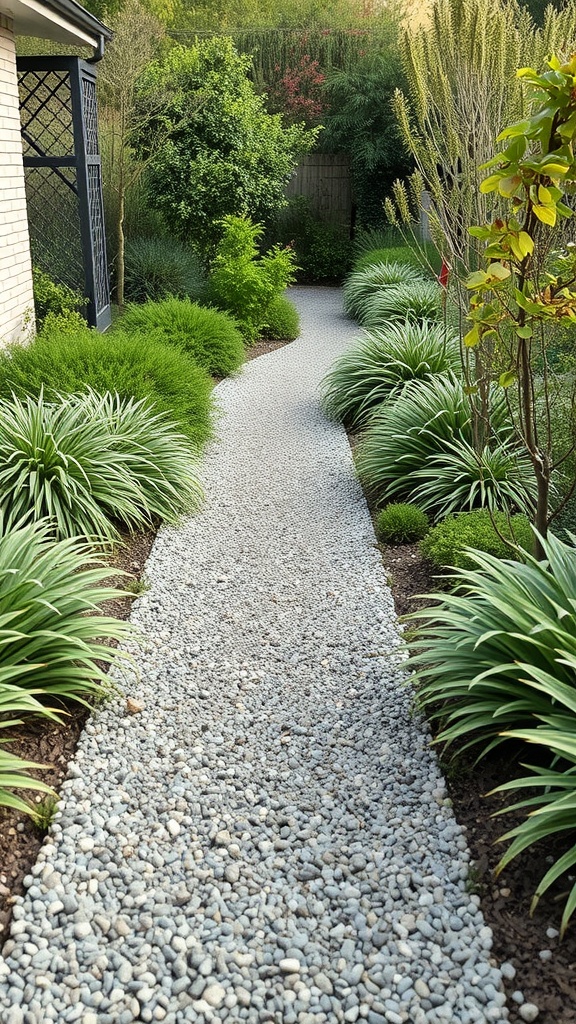
Gravel pathways are a charming and practical way to navigate through your dry garden. They add texture and contrast to the greenery around them, creating a visual flow. In the image, you can see a lovely gravel path winding its way through lush plants, inviting you to explore more of the garden.
This type of pathway is not only easy to install but also requires minimal maintenance. The smooth stones complement the surrounding foliage, highlighting the beauty of both the path and the plants. Plus, gravel helps with drainage, making it a smart choice for areas that might be prone to puddling.
To create a similar look, start by laying a solid foundation. You can use landscape fabric to prevent weeds from growing through the gravel. After that, simply spread your chosen gravel evenly to form a smooth surface. You’ll love how it enhances your garden’s overall appeal while providing a clear route for visitors.
Succulent Rock Garden
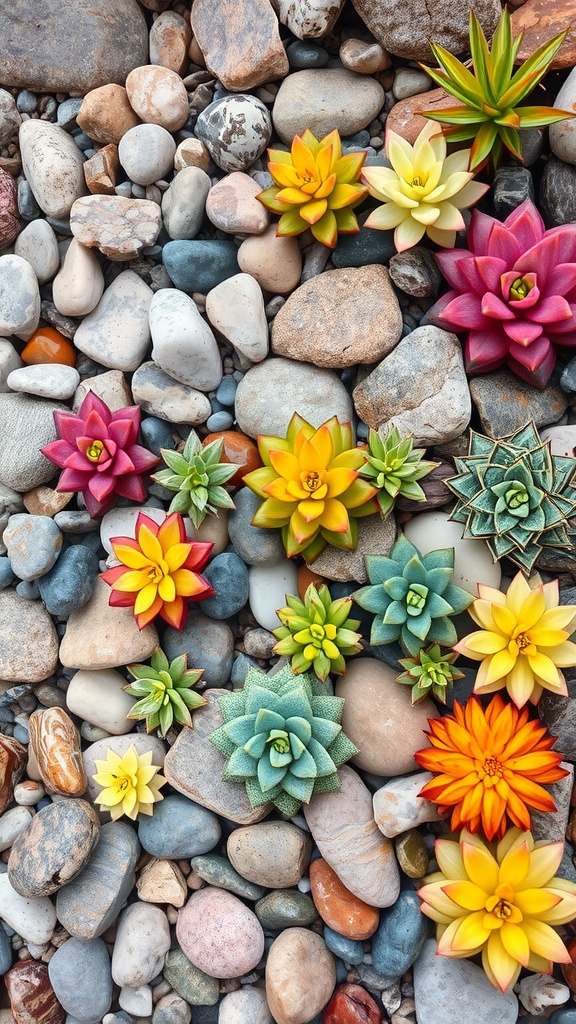
Creating a succulent rock garden is a delightful way to add color and texture to your outdoor space. This design features a variety of succulents interspersed among smooth pebbles and larger stones. The combination of vibrant greens and warm hues from the succulents against the earthy tones of the rocks creates a visually appealing contrast.
Succulents are perfect for dry gardens because they require minimal water and thrive in sunny conditions. Their unique shapes and sizes can be arranged in endless ways, allowing for personal creativity. In this layout, you can see clusters of succulents in different shades of pink, yellow, and green, making it not just a garden, but a lively canvas.
To maintain your succulent rock garden, ensure proper drainage and avoid overwatering. You can also mix in some drought-resistant plants alongside your succulents to enhance diversity. Overall, this garden style is not just easy to care for but also a charming addition to any dry garden theme.
Cactus Collection Display

Cactus collections can be a fantastic way to showcase these unique plants in your dry garden. In the image, various cacti are arranged in different pots, creating a visually appealing display. The mix of shapes and sizes adds interest, making it a fun focal point in any garden space.
Using terracotta and neutral pots can enhance the overall aesthetic. The earthy tones complement the green of the cacti, allowing them to stand out. Grouping cacti of varying heights creates depth and makes the display more dynamic.
Another great aspect of cacti is their low maintenance nature. They thrive in dry conditions and require minimal watering, making them perfect for those who may not have a lot of time to dedicate to garden care. This collection showcases the beauty of drought-resistant plants.
Xeriscape Design
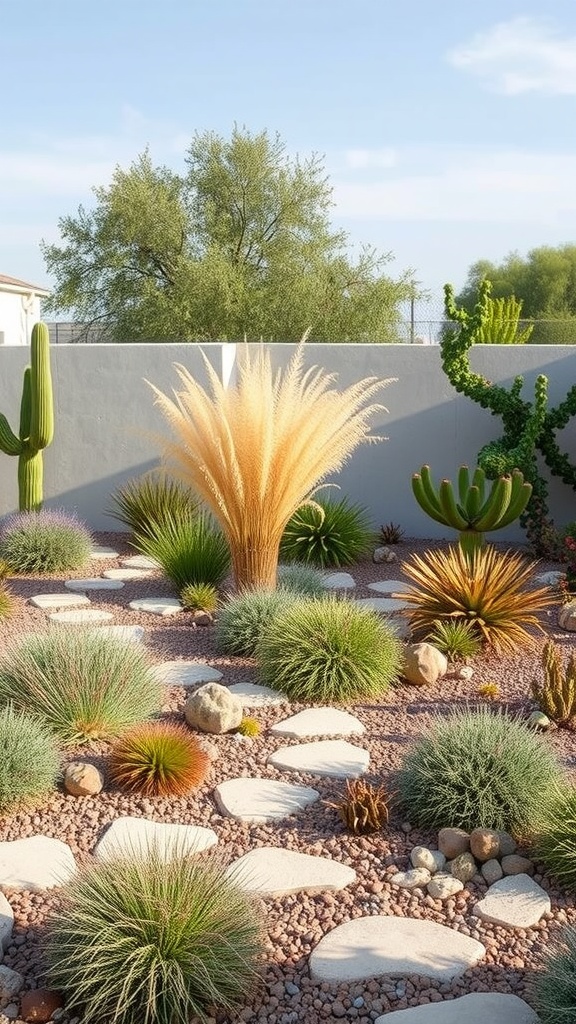
Xeriscape design is all about creating a beautiful outdoor space that thrives with minimal water. The image captures a stunning xeriscape garden filled with various drought-resistant plants and strategically placed stones. The combination of textures and colors makes the garden visually appealing while staying practical.
The fluffy grass-like plant at the center draws attention and adds vertical interest. Surrounding it are low, bushy plants that provide a lush look without high water needs. The use of decorative rocks and stepping stones enhances the landscape while ensuring efficient drainage.
This dry garden idea is perfect for anyone looking to conserve water and reduce maintenance. The layout is simple yet effective, making it easy to navigate and enjoy. With thoughtful planning, xeriscaping can create a serene retreat right in your backyard.
Sedum Ground Cover
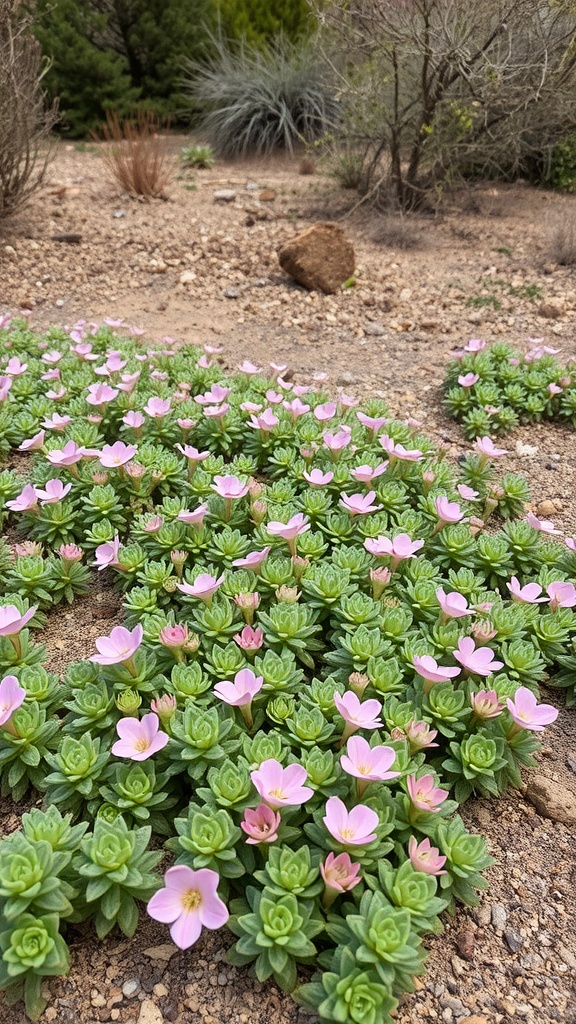
When it comes to creating a dry garden, choosing the right ground cover is key. Sedum is a popular choice for many gardeners, and it’s easy to see why. This hardy succulent thrives in various conditions while adding a vibrant touch to your landscape.
The image showcases a lush carpet of sedum adorned with delicate pink flowers. These blooms bring a pop of color that brightens up the arid surroundings. The fleshy, green leaves of the sedum create a thick mat, which helps to suppress weeds and retain moisture in the soil.
Planting sedum is simple. It adapts well to poor soil and requires minimal watering. Make sure to select a sunny spot for your garden, as sedum loves sunlight. You can plant it in clusters or in a more scattered fashion, depending on your design preferences.
Besides being low maintenance, sedum is also drought-resistant. This makes it an excellent choice for those looking to conserve water in their garden. It’s perfect for rock gardens, pathways, or even between stepping stones. Not only does it look great, but it also helps to create a sustainable landscape.
Incorporate sedum into your dry garden plan, and enjoy a beautiful and eco-friendly space. You’ll appreciate the ease of care and the cheerful blooms that come with it!
Boulders as Focal Points

Boulders can serve as striking focal points in a dry garden, creating an eye-catching feature that draws attention. In the image, large, smooth boulders are scattered across a sandy landscape, providing a sense of natural beauty. These stones not only add texture but also contrast beautifully with the surrounding greenery and ground cover.
The arrangement of boulders can help define spaces within the garden. For example, the circular stone path in the image leads to a decorative element, which adds character. This setup encourages exploration and invites visitors to navigate through the garden.
Integrating boulders into your landscape design can enhance the overall aesthetic. They provide a solid structure that complements the softness of plants around them. Additionally, the use of different sizes and shapes can create visual interest, making each area unique.
Low-Water Vegetable Garden
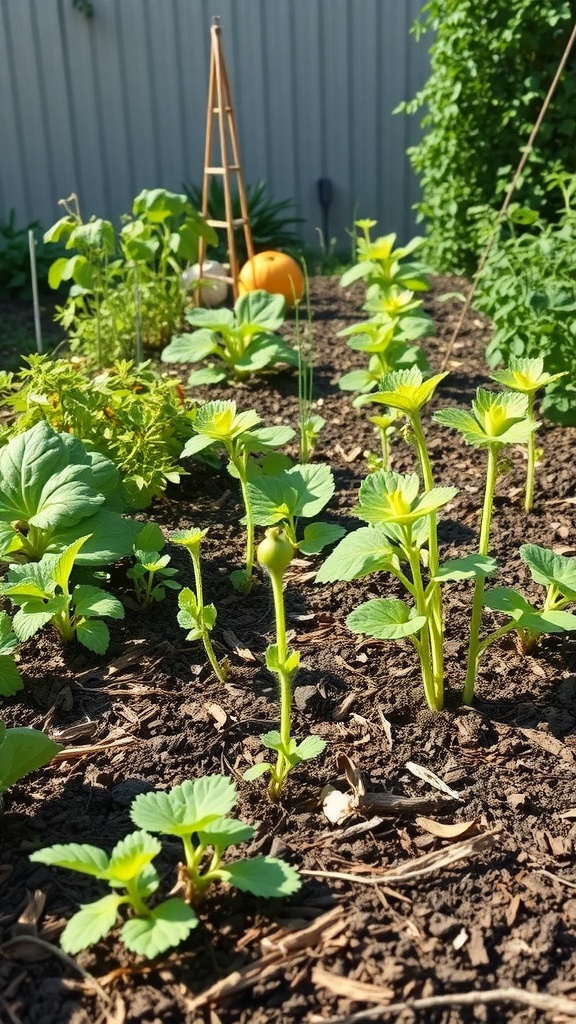
A low-water vegetable garden is a smart way to grow fresh produce while conserving water. In this image, you can see a vibrant garden brimming with healthy plants. The layout is neat, allowing for easy access to each plant. You’ll notice a mix of leafy greens and budding vegetables, all thriving in well-prepared soil.
These plants are not only visually appealing but also efficient in water use. By selecting drought-resistant varieties, you can enjoy a flourishing garden that requires minimal watering. The use of mulch helps retain soil moisture and suppress weeds, making maintenance easier.
Consider incorporating vegetables like zucchini, squash, and certain herbs that thrive in dry conditions. With proper planning and care, you can create a productive garden that contributes to sustainability. Remember to space out the plants adequately to allow for air circulation and sunlight, which both promote healthy growth.
Dry Stream Bed
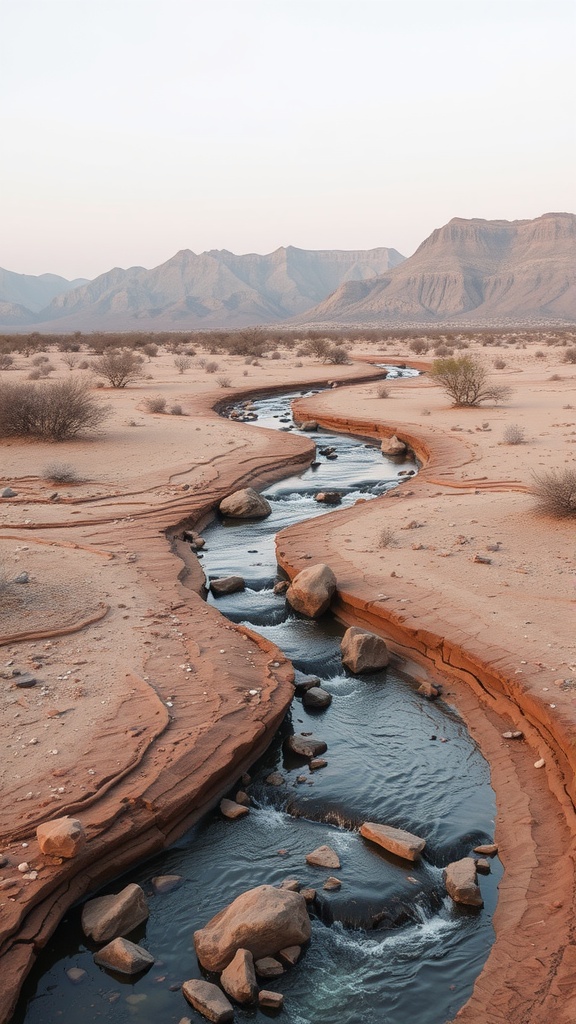
A dry stream bed can be a beautiful and functional feature in a garden. It mimics the natural patterns of water flow, even when the stream isn’t running. In the image, you can see a winding path carved into sandy terrain, flanked by rocks and gentle slopes.
This design not only adds visual interest but also helps with drainage. When it rains, water can flow along the bed, preventing pooling in other areas of the yard. It’s a smart way to manage water while maintaining a natural look.
Incorporating a dry stream bed into your garden can also provide a habitat for local wildlife. Birds and small animals may be attracted to the area, adding life and movement to your space. Plus, you can easily plant drought-resistant plants and grasses along the edges to enhance the beauty of your garden.
Overall, a dry stream bed is a simple yet effective way to create a unique landscape feature. It offers both functionality and aesthetic appeal, making it a great choice for dry garden designs.
Cacti and Succulent Wall
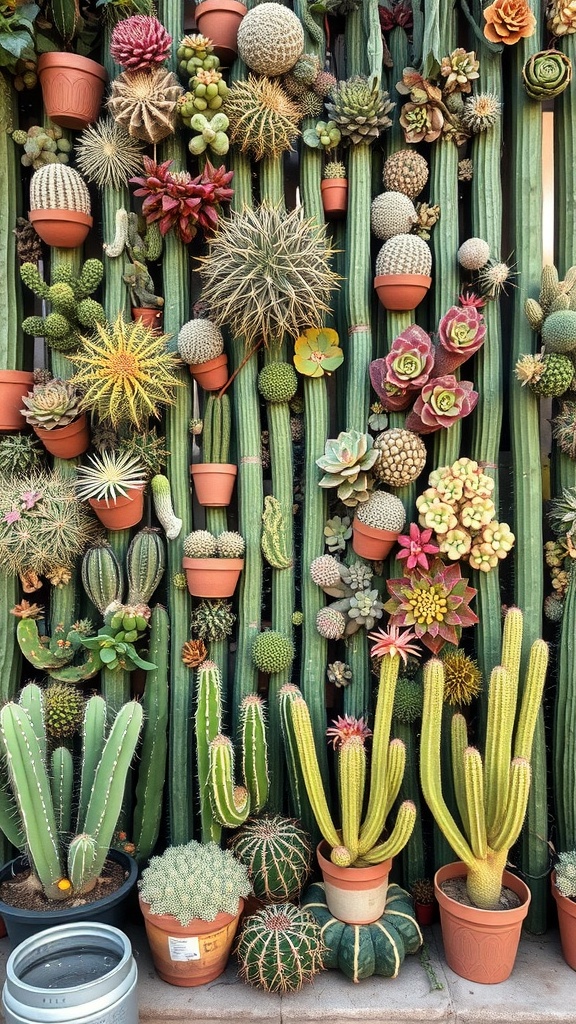
A cacti and succulent wall is a beautiful way to bring life and color to any dry garden. This vibrant display features a variety of cacti and succulents arranged in a visually appealing way. Each plant boasts unique shapes, colors, and textures, making the wall a stunning focal point.
In the image, you can see cacti of different sizes and types mounted on a sturdy vertical surface. The use of terracotta pots adds a rustic charm, and the green backdrop enhances the natural beauty of each plant. This setup is not only eye-catching but also a great way to maximize space in a garden.
Creating your own cacti and succulent wall is quite simple. Start by selecting a suitable wall or fence. Then, choose a variety of plants that thrive in dry conditions. Arrange them in pots or directly on the wall, ensuring that taller plants do not overshadow smaller ones. It’s a fun project that adds character to your outdoor space while being low-maintenance.
Recycled Material Features
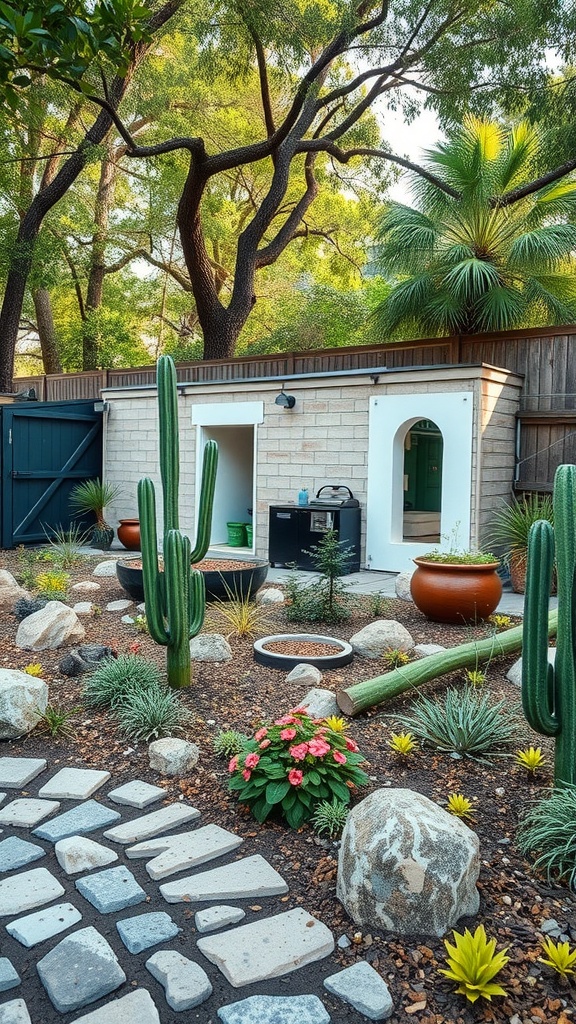
Incorporating recycled materials in your dry garden can add a unique charm, as seen in the image above. The path made from various stone slabs mixes well with natural elements, offering a rustic feel.
The use of old planters and pots, like the round ones in the image, showcases creativity while being eco-friendly. Their earthy tones complement the greenery and the surrounding rocks perfectly.
Notice the way the stones are placed around the cacti and plants? This not only creates visual interest but also conserves moisture in the soil, making it ideal for a dry garden. Recycled materials can provide texture and depth, enhancing the overall aesthetic.
The backdrop features a simple structure that feels inviting. This highlights how recycled elements can harmonize with functional spaces, making them both practical and appealing.
Using broken tiles or bricks in the garden can also create interesting patterns and pathways, similar to what is showcased in this design. It’s a fantastic way to repurpose items that would otherwise go to waste.
Rustic Wooden Planters
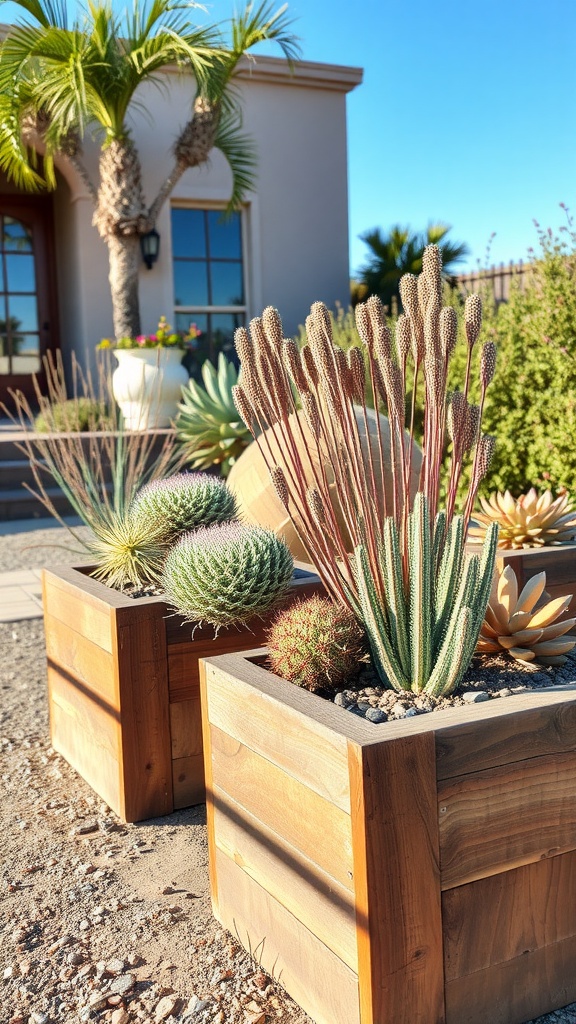
Rustic wooden planters add a charming touch to dry gardens. In this image, you can see beautifully crafted wooden boxes that perfectly showcase a variety of succulents and cacti. These planters not only provide a natural aesthetic but also blend seamlessly with the surrounding landscape.
The warm tones of the wood contrast nicely with the vibrant greens and subtle pastel hues of the plants. This combination creates a relaxed and inviting atmosphere. The wooden planters elevate the overall design, making each plant stand out, while also providing a sturdy home for them.
Using wooden planters is a practical choice for dry gardening. They allow for excellent drainage, which is essential for succulents that thrive in drier conditions. Plus, they can be customized in size and shape to fit any space in your garden.
Consider adding decorative stones or gravel around the plants inside the planters. This not only enhances the visual appeal but also helps retain moisture in the soil. Overall, rustic wooden planters are a simple yet effective way to highlight the beauty of a dry garden.
Colorful Desert Blooms
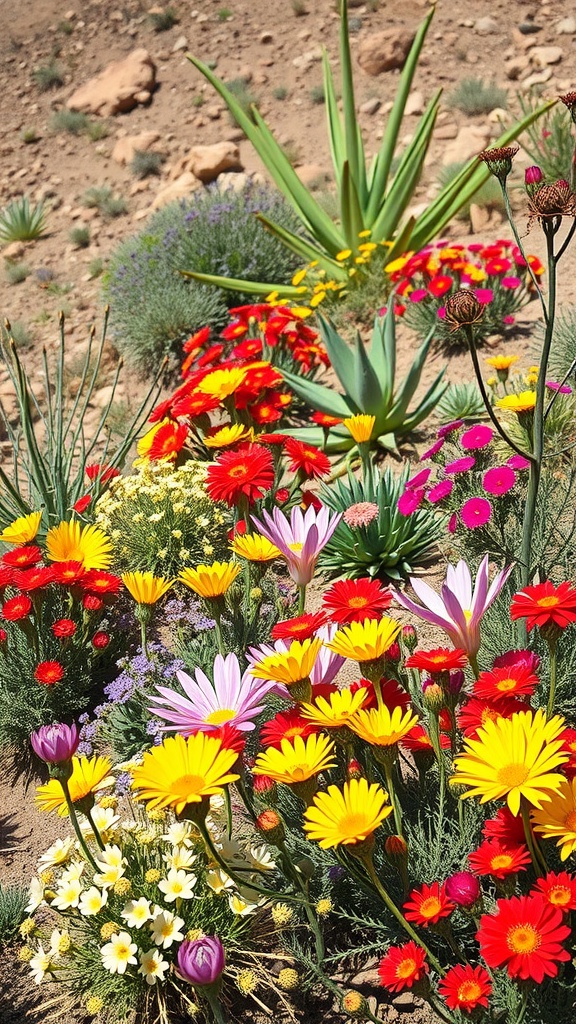
Desert gardens can be vibrant and alive, as shown in this beautiful scene. The mix of colors from the flowers creates a lively and inviting space. Bright reds, yellows, and pinks pop against the earthy tones of the desert backdrop. This arrangement shows how desert plants can thrive and add character to dry landscapes.
Incorporating a variety of flowers not only brings beauty but also attracts pollinators like bees and butterflies. It’s a win-win for both aesthetics and nature. Pairing colorful blooms with hardy succulents and cacti can create a balanced and harmonious garden. You can enjoy the flowers while appreciating the resilience of these plants.
Consider planting species like Gerbera daisies, which add a cheerful note with their bold colors. Additionally, the greens of succulents provide a lovely contrast, making the flowers stand out even more. With careful planning, your dry garden can turn into a vibrant escape, filled with life and color.
Native Plant Borders
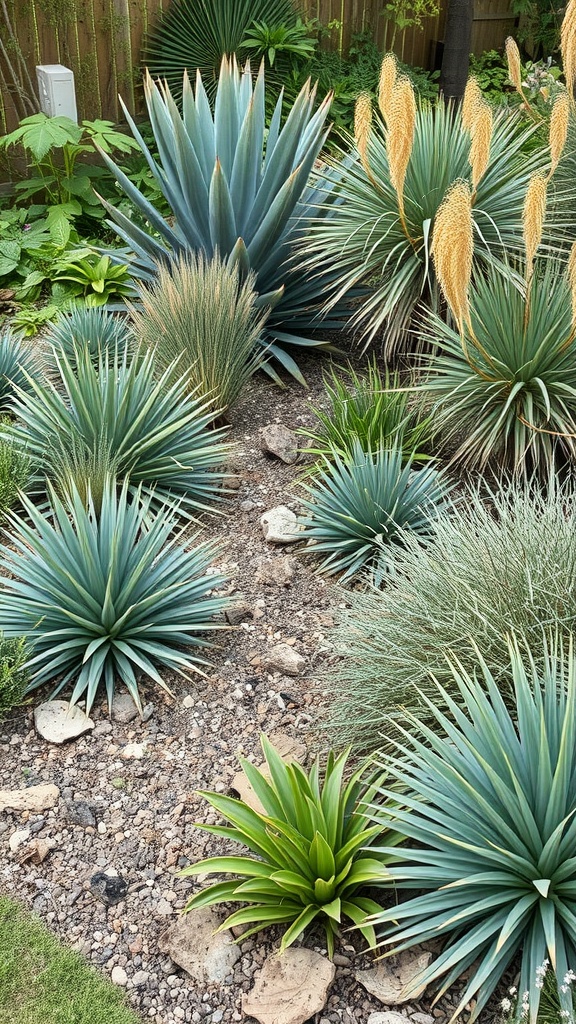
Native plant borders are a fantastic way to create a vibrant and sustainable garden space. The image showcases a lovely arrangement of various native plants that thrive in dry conditions. These plants not only add visual interest but also support local wildlife.
The unique shapes and textures of the plants featured create a beautiful contrast with the surrounding gravel and rocks. Notice how the tall, spiky leaves of some plants provide a dramatic focal point, while the softer, bushier varieties fill in the gaps. This mix adds depth and dimension to the garden.
Choosing native plants ensures that your garden is low-maintenance and well-adapted to your local climate. These plants also require less water, making them an eco-friendly option. Plus, they often attract pollinators like bees and butterflies, enhancing the overall biodiversity of your garden.
Fire Pit Surrounded by Stones

A fire pit can transform your dry garden into a cozy retreat. This setup is all about gathering with friends and family while enjoying the warmth of a fire. The surrounding stones create a natural and rustic feel, blending seamlessly with the landscape.
The circular arrangement of stones around the fire pit not only defines the space but also offers safety. It keeps the fire contained, allowing everyone to enjoy the ambiance without worry. The choice of rocks adds texture and character to the garden.
Surrounding the pit with a variety of plants enhances the atmosphere. Low-maintenance succulents can thrive in dry conditions, providing a pop of color and life. The combination of the fire’s glow and the plants creates a serene environment perfect for evening gatherings.
Incorporating a few comfortable seating options around the fire can make it even more inviting. Picture a few chairs or benches, where you can relax and share stories under the stars. This space encourages connection and relaxation, making it a wonderful addition to any dry garden.
Bamboo Fencing in Dry Gardens
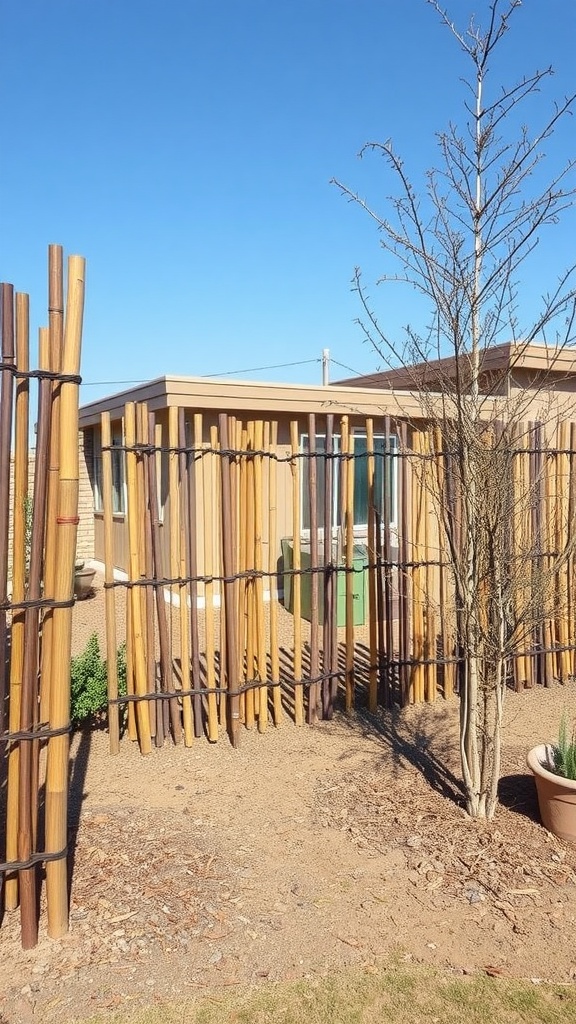
Bamboo fencing is a stylish and practical choice for dry gardens. It brings a natural look that blends well with the surrounding landscape. The tall bamboo poles in the image create a sense of privacy without overwhelming the space.
This type of fencing is not only visually appealing but also functional. Bamboo is known for its durability, making it a great long-term investment. Plus, its lightweight nature allows for easy installation and adjustments as needed.
Incorporating bamboo fencing can also help define garden areas. It can separate different sections of your dry garden, making it easier to organize plants and pathways. The earthy tones of bamboo complement the drought-resistant plants typically found in these gardens.
Another benefit is that bamboo fencing is eco-friendly. It’s a renewable resource that can enhance your garden’s sustainability. So, if you’re aiming for an environmentally conscious garden, bamboo is a smart choice.
Overall, bamboo fencing not only enhances the aesthetic of a dry garden but also serves practical purposes. It adds structure, privacy, and a touch of nature, making it an ideal element for any dry garden design.
Succulent Fairy Garden

A succulent fairy garden is a delightful way to bring a touch of whimsy to your outdoor space. This little world combines the charm of miniature decorations with the hardiness of succulents. The vibrant greens of the plants add life, while tiny figurines and decorative stones create a story.
In the image, you can see a variety of succulents nestled among colorful pebbles and playful decorations. There are little houses, a few whimsical characters, and even a cute dinosaur, making the scene inviting and fun. The use of different textures—from the smooth pebbles to the soft leaves of the succulents—adds depth to the design.
Creating your own succulent fairy garden can be a rewarding project. Start by choosing a container that fits your style, like a shallow pot or a wooden box. Select a variety of succulents for diverse shapes and colors. Then, let your imagination run wild with miniature decorations. You can add tiny furniture, figurines, or even small rocks to mimic a fairytale environment.
Don’t forget to consider the light and water needs of your succulents. They thrive in bright, indirect sunlight and need minimal watering. This makes them a perfect choice for a low-maintenance garden that still brings joy and creativity to your space.
Rain Garden Elements

This image beautifully illustrates the concept of a rain garden, a clever way to manage water runoff while enhancing your outdoor space. The path made of stone slabs invites you to explore the garden, creating a gentle flow through the greenery.
At the sides of the path, you can see ornamental grasses that add height and texture. These plants are not just for looks; they help with water absorption, making them a smart choice for any rain garden. The vibrant flowers in the background bring a splash of color, making the garden feel lively and welcoming.
The use of natural materials like mulch and stone not only looks appealing but also helps in retaining moisture in the soil. This combination creates a lush environment that attracts beneficial insects and birds. It’s a perfect example of how rain gardens can be both functional and beautiful!
Terracotta Pots with Drought Tolerant Plants
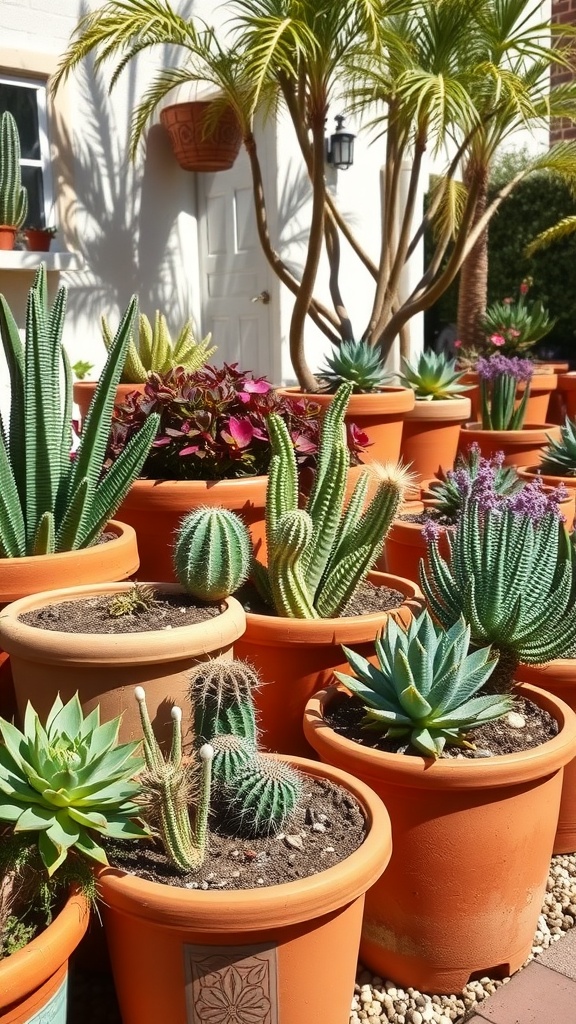
In the realm of dry gardening, terracotta pots stand out for their rustic charm and practicality. These pots create a beautiful contrast against the vibrant greens and striking colors of drought-tolerant plants. From succulents to cacti, the variety of plants in terracotta pots adds visual interest to any outdoor space.
Arranging different shapes and sizes of pots can turn a simple garden into an eye-catching display. The warm tones of terracotta complement the natural hues of the plants. This combination not only enhances the garden’s aesthetics but also provides a unique texture.
When choosing plants, consider species that thrive in dry conditions. Succulents like aloe and agave are perfect for terracotta pots. They require minimal water and can handle the heat. Plus, their diverse shapes and colors can really brighten up your garden.
To create a stunning terracotta display, group pots of varying heights together. This layering effect adds depth and makes the arrangement more dynamic. Be sure to position your pots where they can receive plenty of sunlight, as most drought-tolerant plants love the heat.
Cacti in Decorative Urns
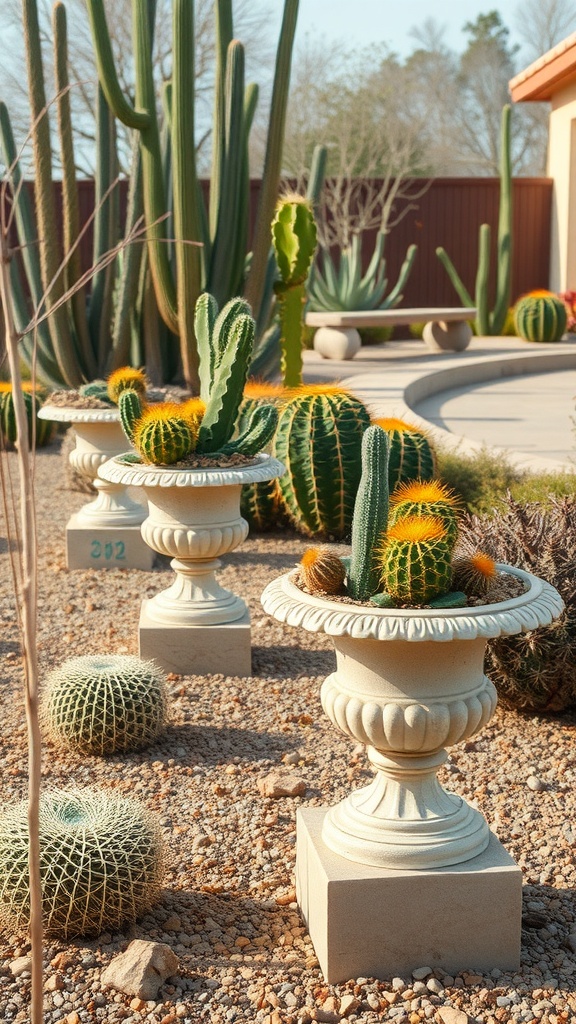
Picture a warm, sunny garden where cacti thrive in decorative urns. This setup not only adds character but also highlights the beauty of these resilient plants. The contrast between the earthy textures of the urns and the vibrant greens and yellows of the cacti creates a visual treat.
Using urns for cacti is a stylish way to elevate your dry garden. Each urn showcases different types of cacti, from tall, slender varieties to round, spiky ones. This mix adds variety and interest to your outdoor space.
These decorative containers also help in organizing your garden layout. Placing urns at varying heights gives depth to the scene. You can create a pathway around them, inviting you to explore the unique textures and shapes of each cactus.
It’s essential to choose urns with good drainage. Cacti thrive in dry conditions, so proper drainage ensures they don’t sit in water, which can lead to rot. Pair your cacti with gravel or rocks around the base to complement the urns and enhance the desert vibe.
Overall, cacti in decorative urns are a simple yet effective way to bring charm to your dry garden. They showcase your creativity while allowing these unique plants to shine.
Textured Pathways with Sandstone
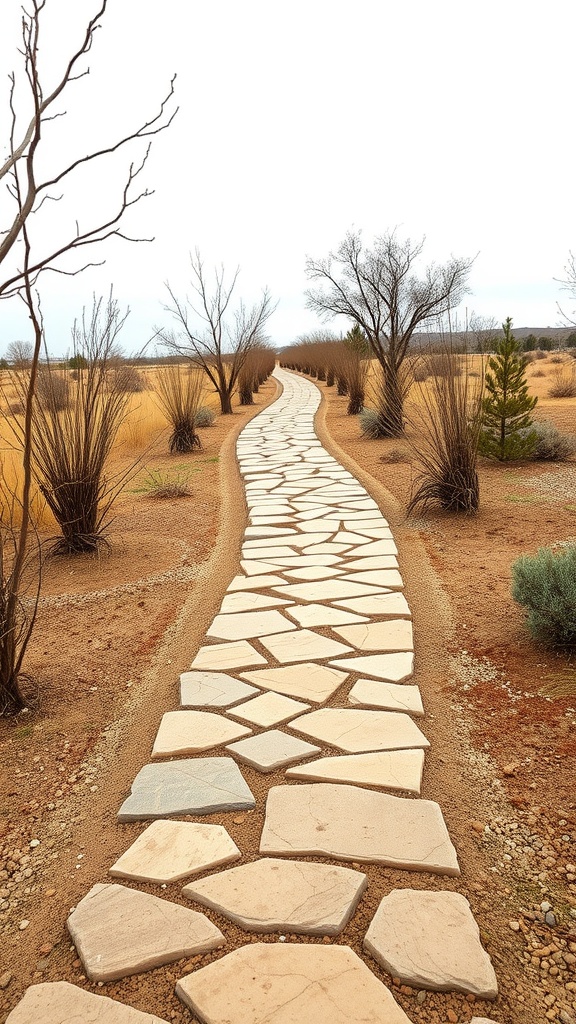
Creating textured pathways with sandstone can really enhance your dry garden. The image depicts a beautifully winding path made from irregularly shaped sandstone pieces. This design not only adds interest but also invites you to explore the garden.
The soft curves of the pathway lead the eye through the landscape, making it feel welcoming. Sandstone is an excellent choice because it blends well with the earthy tones of the surrounding area. This adds a natural feel to your space, harmonizing with the plants and mulch.
Alongside the path, you can see sparse vegetation. This minimalist approach is often favored in dry gardening, allowing the pathway to stand out. The delicate dry branches and subtle greenery on either side frame the path beautifully.
Incorporating pathways like this not only serves a practical purpose but also enhances the overall aesthetic. Think about adding some low-maintenance plants alongside to create a vibrant contrast to the sandstone. It’s a simple way to keep things interesting without overwhelming the space.
Potted Yucca Plants
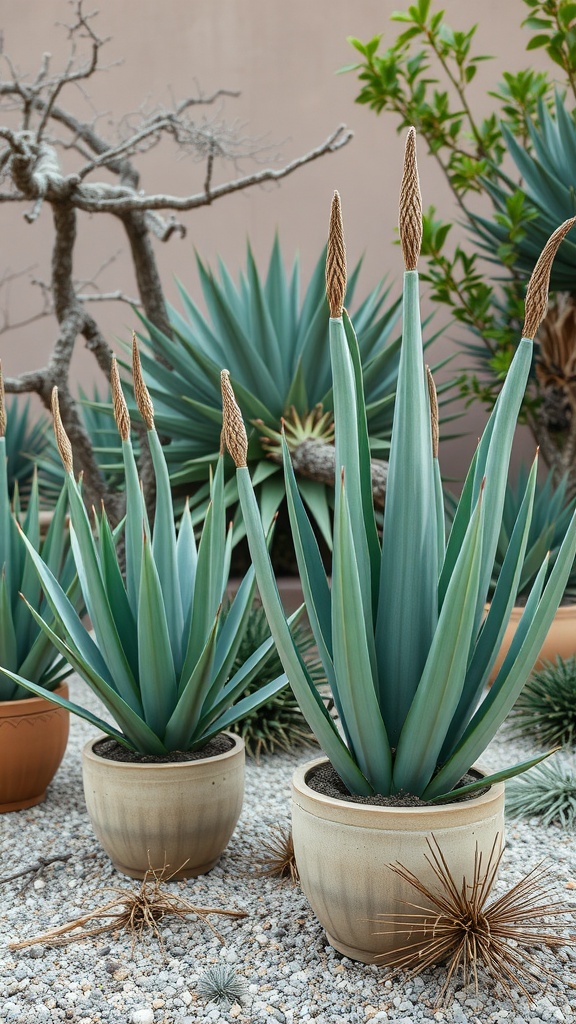
Potted yucca plants make a striking addition to any dry garden setup. Their tall, sharp leaves bring a bold look that stands out in a landscape. With their unique structure, they not only add visual interest but are also quite low-maintenance.
In the image, you can see two potted yuccas, each showing off their long, green leaves that point upward. This creates a beautiful vertical element in the garden. The pots themselves have a simple, earthy tone that complements the plants well, adding to the overall aesthetic.
Yucca plants thrive in dry conditions, making them ideal for drought-resistant gardens. They require minimal watering and can handle direct sunlight, which is a plus if you’re looking to conserve water and upkeep.
One of the cool features of yuccas is their ability to produce tall flower spikes. While these plants are mainly appreciated for their foliage, their blooms can add another layer of beauty when they appear. This means you get a dynamic look that changes through the seasons.
When designing your dry garden, consider grouping yucca plants with other drought-resistant species to create a cohesive look. The combination of textures and shapes will make your garden feel lively and inviting.
Dry Garden Art Installations
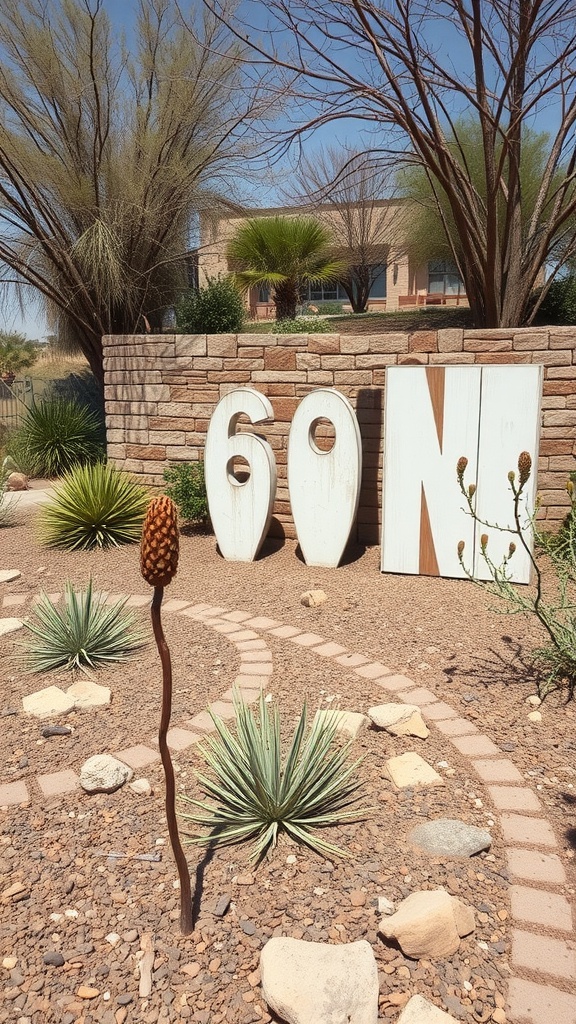
Incorporating art into dry gardens can elevate their appeal. The image above shows a unique installation that adds character to the landscape. The playful combination of natural elements and artistic touches creates a vibrant atmosphere.
The striking wooden letters spelling ’69 N’ stand tall against a backdrop of carefully arranged desert plants and stones. This kind of art installation not only serves as a focal point but also invites visitors to engage with the space. It’s all about blending creativity with nature.
In the foreground, the metal sculpture resembling a blooming flower adds an intriguing touch. This piece complements the surrounding greenery while standing out on its own. Such installations encourage gardeners to experiment with different materials and designs, making dry gardens feel more dynamic.
When designing your dry garden art, consider elements like color, shape, and texture. Simple additions can make a big impact. From colorful pottery to artistic sculptures, the possibilities are endless. Choose pieces that resonate with you and enhance the overall theme of your garden.
Desert Themed Outdoor Seating
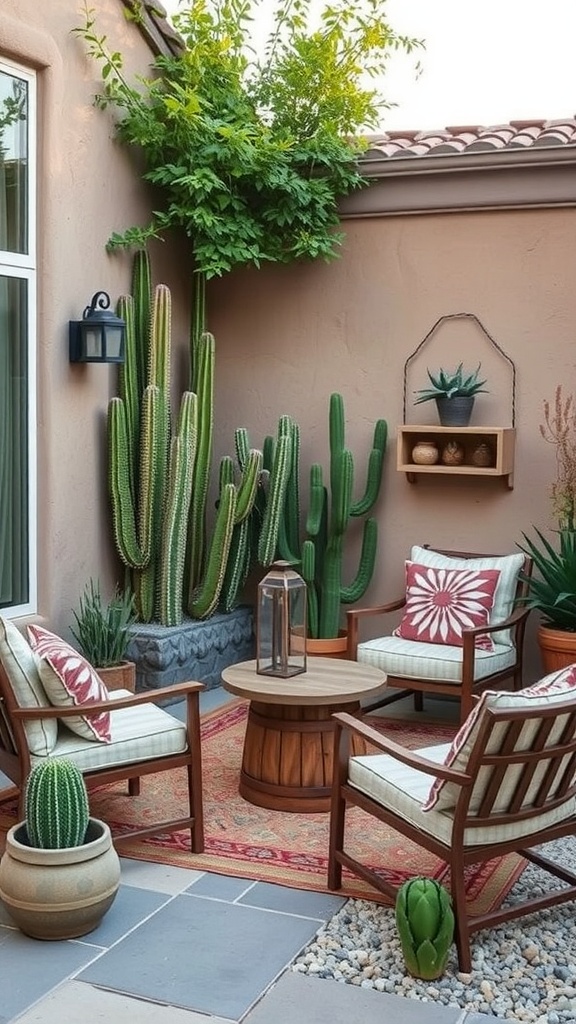
If you’re dreaming of a cozy outdoor space that embraces the desert vibe, this setup is a great example. The combination of earthy tones, natural materials, and desert plants creates a relaxing atmosphere.
The seating arrangement features two comfortable chairs with soft cushions, inviting you to kick back and enjoy the scenery. The round table in the center is perfect for drinks or snacks, making it an ideal spot for gatherings.
Cacti and other succulents add a touch of greenery without requiring too much maintenance. You can easily find similar plants at local nurseries. The use of vibrant cushions with floral patterns brings a pop of color, balancing the neutral tones of the surroundings.
A decorative lantern adds a warm glow for those evening chats under the stars. The overall layout encourages relaxation, making it a great place to unwind after a long day.
Succulent Arrangement on a Table
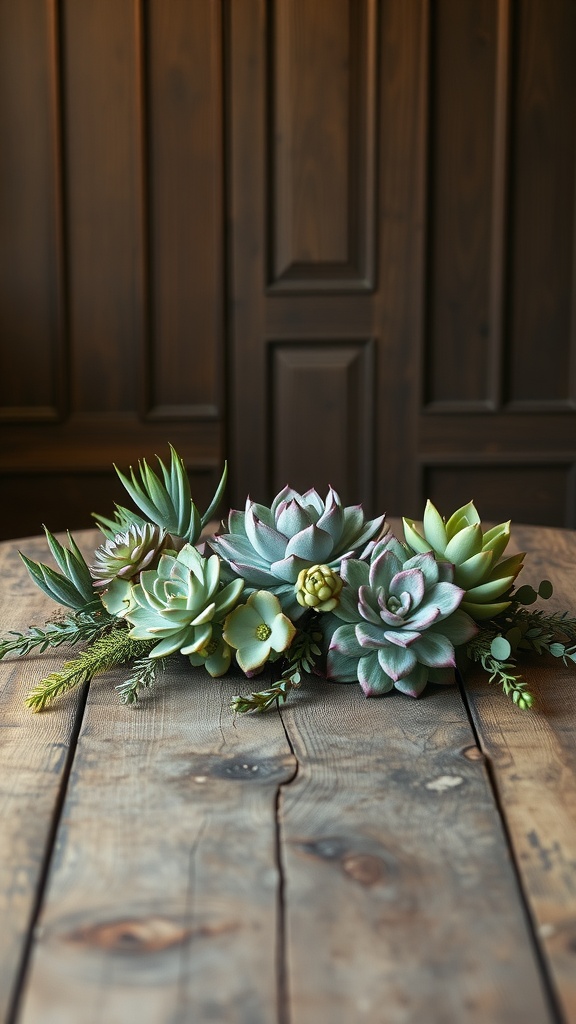
This succulent arrangement is a delightful way to bring a touch of nature indoors. Placed on a rustic wooden table, the various shades of green and hints of pink from the succulents create a cozy and inviting atmosphere.
The arrangement features a mix of different succulent types, each with its unique shape and texture. Some are round and plump, while others have longer, more slender leaves. This variety adds visual interest and makes the display more dynamic.
In addition to the succulents, there are also some green accents that enhance the overall look. These can be small sprigs of foliage that add depth and a pop of color, tying everything together beautifully.
Using succulents in your home decor is not only stylish but also low maintenance. They require minimal watering and can thrive in different lighting conditions, making them perfect for busy lifestyles. Consider placing this arrangement on a kitchen table, side table, or even a coffee table to create a warm and welcoming space.
Mulched Plant Beds
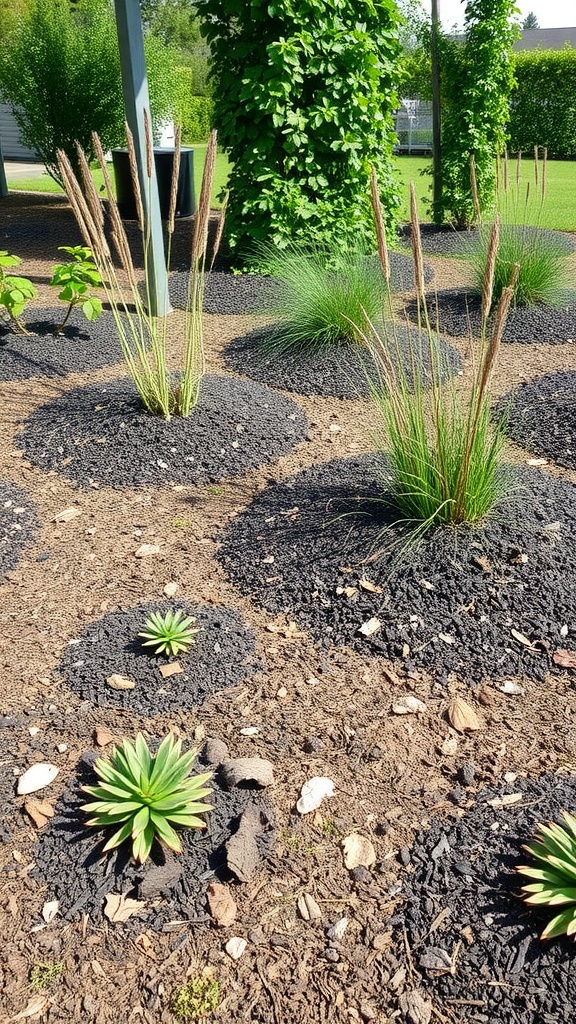
Mulched plant beds are a smart choice for a dry garden. This image showcases a variety of plants nestled on mounds of dark mulch, creating an attractive and organized landscape. The use of mulch helps retain moisture in the soil while reducing the growth of weeds.
The plants in the photo range from spiky grasses to rosettes of succulent foliage. Their arrangement in circular beds adds visual interest and makes maintenance easier. Each plant has its own space, which allows for good air circulation and sunlight exposure.
Using mulch not only looks good but also benefits the plants. It keeps the soil temperature consistent and protects the roots from extreme heat. Plus, mulched beds require less frequent watering, making them a practical choice for anyone looking to conserve water.
So, if you’re considering adding some green to your dry garden, think about incorporating mulched plant beds. They offer a simple and effective way to create a low-maintenance garden that still has plenty of character.
